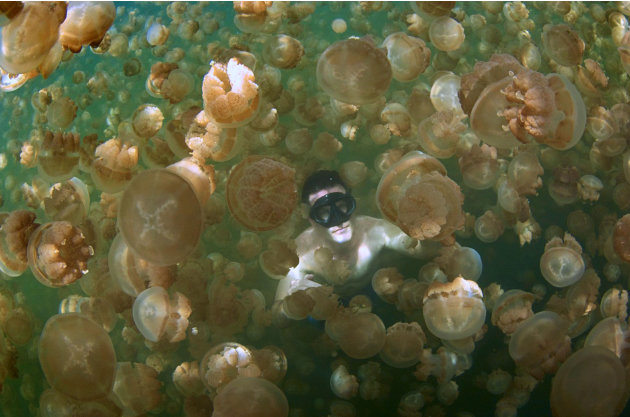 I was remarkably surprised at how much of next year's firewood will have come just from chopping down four or five branches off one old tree..
I was remarkably surprised at how much of next year's firewood will have come just from chopping down four or five branches off one old tree..Thursday, March 01, 2012
THE FIRST STEPS TO SELF SUFFICIENCY
 I was remarkably surprised at how much of next year's firewood will have come just from chopping down four or five branches off one old tree..
I was remarkably surprised at how much of next year's firewood will have come just from chopping down four or five branches off one old tree..SWIMMING WITH JELLYFISH

YAHOO NEWS: At Jellyfish Lake in the Pacific island of Palau, it's safe to swim among millions of jellyfish, because the sometimes-deadly creatures have lost their sting.
OLL LEWIS: Yesterday's News Today
http://cryptozoologynews.blogspot.com/
On this day in 1882 Roderick McLean attempted to assassinate Queen Victoria in response to a curt reply he had been sent after sending some of his poetry to the Queen. He was found ‘not guity but insane’ by a jury at his subsequent trial and lived out his days as an inmate at Broadmoor. As a result of this case English law was changed to allow a person to be considered guilty for a crime but still insane.
And now the news:
T. Rex's Bite More Dangerous Than Previously Belie...
The fox and the hound: Meet unlikely friends Sadie...
Rescuing wildlife: the family of water rats (Part ...
Analysis of the Peter MacNab Photograph
Why flatworms may hold the secret to immortality
Ice Age Coyotes Were Supersized Compared to Coyote...
What sound means to squid
Elephant Behavior and Conservation Issues
$4.5 million fine US industrial for distributing c...
Victoria:
DALE DRINNON: Land bridges, the Canvey Island sea serpent, giant dragon lizards and freshwater monkeys

New at Frontiers of Anthropology:
http://frontiers-of-anthropology.blogspot.com/2012/02/continuing-evidence-for-landbridges-and.html
New on the Frontiers of Zoology:
A rather obscene-looking little monster picture floating around the internet is derived from the washed-up corpse of a very ugly fish:
http://frontiersofzoology.blogspot.com/2012/02/canvey-island-monster-non-cryptid.html
The next part in the Bunyips series involving Giant Dragon Lizards:
http://frontiersofzoology.blogspot.com/2012/02/dragon-lizard-bunyips.html
And an administrative notice, announcing Tyler Stone's posting about the Freshwater Monkeys theory on his own new blog:
http://frontiersofzoology.blogspot.com/2012/02/tyler-stones-case-for-freshwater-monkey.html
BIG CAT NEWS: All sorts of stuff
 The hunt for British Big Cats attracts far more newspaper column inches than any other cryptozoological subject.
The hunt for British Big Cats attracts far more newspaper column inches than any other cryptozoological subject.
There are so many of them now that we feel that they should be archived in some way by us, so we should have a go at publishing a regular round-up of the stories as they come in.
It takes a long time to do, and is a fairly tedious task, so I am not promising that they will be done each day, but I will do them as regularly as I can. JD
Second big cat sighting
Spalding Today
Tuesday, noon - A SECOND big cat was sighted in South Holland yesterday (Monday) – just four days after mum Louise Gann spotted what she thinks was a black panther in a field in Holbeach. Company environmental manager Jeremy Greaves found a big cat in ...
Third big cat sighting
Spalding Today
I'm not keen on politicians in general but this man is scum. He is the reason people like me refer to people like him as 'Pigs':
California Fish & Game Commissioner Bags a Big Cat In Idaho; Californians ...
Patch.com
A "trophy shot" of the Golden State's top Fish and Game Commission official hugging the carcass of a mountain lion he'd just treed and shot has Californians steaming. By JD O'Connor Dan Richards gets his mountain lion. Idaho Outdoor News For decades ...
http://www.thepetitionsite.com/1/remove-dan-richards-from-the-california-fish-game-commission/
Prowling panther or benign bunny?
www.solihullnews.net
DOES a big cat stalk the streets of Marston Green? The answer, according to experts, is no. Kieron McArdle, aged 41, was baffled when he spotted a trail of unusual footprints in a village car park. They had been left on the ground following the flurry ...
Here is another piece of news from the other side of the Atlantic which will probably - especially when you bear in mind the effect of the 1977 Dangerous Wild Animals Act on UK mystery cat reports - have an important impact on mystery cats in the USA:
Bipartisan Bill Prohibiting Private Possession of Big Cats introduced in House ...
MarketWatch (press release)
It is estimated that there are 10000 to 20000 big cats currently held in private ownership in the US, although the exact number remains a mystery. In the past 21 years, US incidents involving captive big cats--tigers, lions, cougars, leopards, jaguars, ...
Mystery as spate of cats found dead in Fulham
Fulham Chronicle
CRYPTOZOOLOGY ONLINE: On The Track (Of Unknown Animals) Episode 55
The latest episode of our monthly webTV show from the CFZ and CFZtv, bringing you news on our activities within cryptozoology and natural history as well as the latest cryptozoological, and monster hunting news from around the world.
A heck of a lot has happened in the last month both within the CFZ, and on the world stage, so this is an extra-long bumper episode
This episode brings you:
CFZ in spring
Waders on Northam Burrows: Shelduck/redshanks/dunlin/curlew/whimbrel
Starling flocks
Great ape prints
Orang pendek research
The mammoth hoax
The Iceland wurm,
mystery tracks,
CFZ at Batnstaple Museum
Chupacabras that isn't
Playing with chainsaws
frogspawn
The ditches of Huddisford
Corinna looks at out of place birds
New and Rediscovered: New chameleon
New and Rediscovered: New seasnake
New and Rediscovered: New bat
New and Rediscovered: New caecilians
New and Rediscovered: New moth
New and Rediscovered: New lizard
Searching for Lars' wife
WW2012
Fortean Fiction
Journal of Cryptozoology
RSPB: Final call for farmers and volunteers – will you Step Up for Nature in 2012?
Last year, the surveys, conducted by a team of over 100 volunteers, produced a “snapshot” of bird life on the region’s farms. Ninety farms, from Gloucestershire to Cornwall, received a free survey in 2011, the highest number in recent years. These surveys are followed by advice about how farmers can manage their farms for wildlife.
Regional Project Officer Felicity Clarke co-ordinates the surveys for the RSPB: “It is such a pleasure to arrange bird surveys for farmers in the region, to find that so many farmers really want to help the wildlife on their farms, and contact us to find out how they can do so while still running their businesses.” These farmers are making a huge step for nature, and we hope that the increased interest shown last year will continue in the coming spring.
“Many farmland birds in the region are doing fine. Three quarters of farms surveyed in 2011 had skylarks and house sparrows and two thirds had linnets and yellowhammers. There are some birds though that do need a helping hand. Only 9% of farms had grey partridge, 8% tree sparrow, 6% yellow wagtail and only one farm had turtle dove. These figures are worrying, but as farmers continue to step up and demand for surveys and advice increases, so does our hope that these numbers can be reversed.
“And although birds like skylark are still abundant, wouldn’t it be fantastic for 100% of farms in the region to be home to this beloved bird?”
Farmers are already registering for this years surveys and new volunteers have been recruited to meet the demand, but the RSPB is today putting out a final call for farmers in south west England. Felicity Clarke: “If you would like a survey, you need to act fast!”
If you are interested in finding out what birds are breeding on your farm, or if you are interested in becoming a volunteer surveyor, please contact Felicity Clarke felicity.clarke@rspb.org.uk or 01392 453774.
The Volunteer and Farmer Alliance is supported through the EU LIFE+ Programme funds which supports wildlife-friendly farming that furthers sustainable development.
For more information and to arrange an interview please contact:
Tony Whitehead, RSPB South West Press Officer 01392 453754, 07872 414365
Additional notes
1. The top five most common birds on south west farms in 2011, as recorded in this survey, were:
Blackbird
Chaffinch
Blue tit
Robin
Swallow
INAPPROPRIATE CORNER: Inappropriate use of photoshop
 There are two questions here:
There are two questions here:1. What was Graham Inglis doing reading the Daily Mail Women's pages when he found this story?
2. Was this chillingly nasty image a screw-up by those who should have known better? Or a deliberate act of malice by some bitchy person or persons unknown?
We don't really care - but it gave us mild amusement for five minutes.

MANY THANKS TO PUCA FOR THIS AMAZING VIDEO OF THE LORD HOWE ISLAND STICK INSECT
Lord Howe Island Stick Insect hatching from Zoos Victoria on Vimeo.
They call it "Ball's Pyramid." It's what's left of an old volcano that emerged from the sea about 7 million years ago. A British naval officer named Ball was the first European to see it in 1788. It sits off Australia, in the South Pacific. It is extremely narrow, 1,844 feet high, and it sits alone.
What's more, for years this place had a secret. At 225 feet above sea level, hanging on the rock surface, there is a small, spindly little bush, and under that bush, a few years ago, two climbers, working in the dark, found something totally improbable hiding in the soil below. How it got there, we still don't know.
Read on...
WEIRD WEEKEND 2012
 There have been quite a few updates on the Weird Weekend 2012 web site. Particularly check out the updated programme and speaker biographies.
There have been quite a few updates on the Weird Weekend 2012 web site. Particularly check out the updated programme and speaker biographies.http://www.weirdweekend.org/
 Whilst on the subject of the event, I want to once again say an enormous `thank you` to Matthew and Emma Osborne, who are being bloody marvellous...
Whilst on the subject of the event, I want to once again say an enormous `thank you` to Matthew and Emma Osborne, who are being bloody marvellous...


















